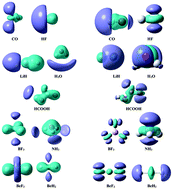N-Derivatives of Shannon entropy density as response functions†
Abstract
The exact first and second order partial derivatives of Shannon entropy density with respect to the number of electrons at constant external potential are introduced as new descriptors for prediction of the active sites of a molecule. The derivatives, which are a measure of the inhomogeneity of electron density, are calculated both exactly (from analytical forms) and approximately (using the finite difference method) for some molecular systems. According to the maximum entropy principle, the extreme value of the first order derivative on the surface of a given molecule should determine the active sites of the molecule in electrophilic and nucleophilic attack. The second order derivative indicates where the Shannon entropy is more concentrated or depleted during the electron exchange. Although these derivatives on the surfaces of helium and neon atoms are uniform, the corresponding values for argon, krypton and xenon atoms are not. This could explain the greater tendency of heavy noble gas atoms to form stable compounds. A dual descriptor is also defined as the difference between the left and right first order derivatives of Shannon entropy density, which allows one to simultaneously predict the preferable sites for electrophilic and nucleophilic attack over the system at point r. Therefore, the reactivity of an atom in a molecule requires the non-uniformity of the first and second order derivatives of Shannon entropy density on the surface of that atom.


 Please wait while we load your content...
Please wait while we load your content...